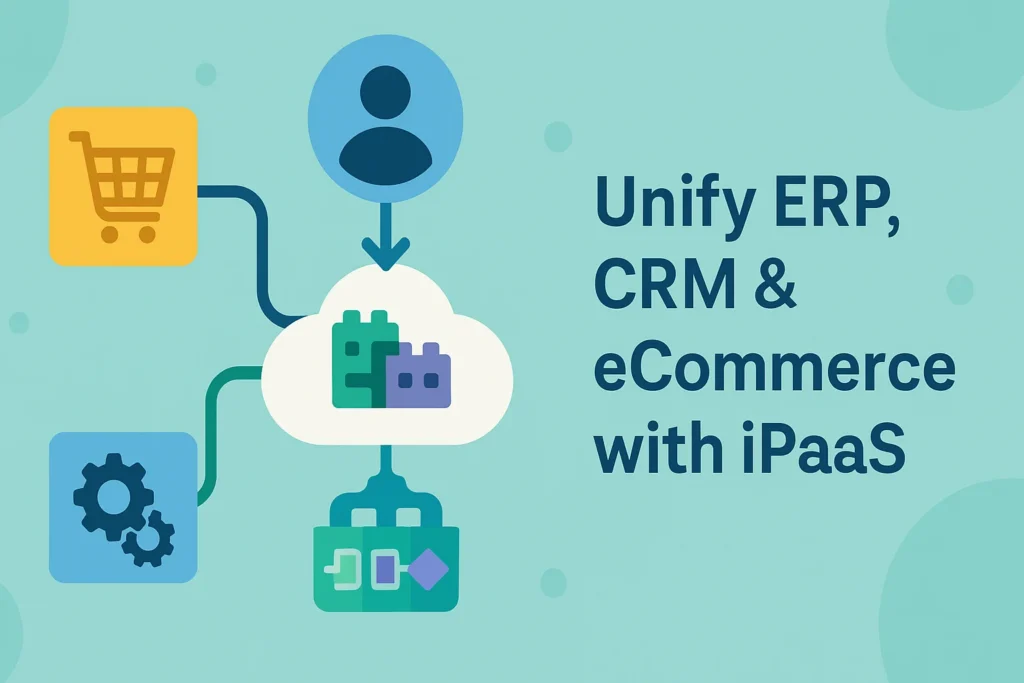Current businesses have an average 1,200 unique software programs in play within their organizations. Your sales team uses Salesforce to manage customer relationships, operations uses SAP to manage resources and marketing uses Shopify or Magento to drive revenue. They are each excellent systems in their own right, but combined they cause operations nightmares.
Data exists in data silos. The customer information is in three formats at your CRM, ERP and eCommerce fronts. When an online order is received, your fulfillment service agent will manually type information into the ERP and the customer service agent will independently update information in the CRM. It is estimated that such a fragmented approach costs enterprises up to $3.1 million a year in the loss of productivity and opportunities.
Advanced platforms like Burq iPaaS solve this fundamental challenge by creating a unified integration backbone that connects your critical business systems seamlessly, eliminating the manual processes that drain productivity and create customer service issues.
Why Do Most Enterprises Struggle with System Integration Complexity?
The transition of one monolithic software to best-of-breed solutions had unintended consequences. Two decades ago, businesses used single ERPs. The digital environment of today necessitates highly specialized tools, designed to carry out predetermined tasks, but few companies envisioned the amount of integration this strategy will bring along.
Your ERP software can capture the inventory levels and financial cash transactions accurately. Your CRM deals with sales pipelines and customer relationships adequately. Your online store increases online sales via customized shopping experiences One platform meets a specific goal, but the other is in another language.
Workarounds become accepted practices without anyone even questioning whether they are manual or not. Sales representatives update CRM records, which record the availability of inventory manually, after scanning the ERP systems. The customer service agents have to shuffle between screens to get a complete history of the customer. Finance teams are importing data spread across multiple platforms into spreadsheets to achieve consolidated reporting.
These activities gobble up 35 percent of employee productivity in disconnected organizations. Of greater concern, they carry along with them inaccuracies that accumulate over systems, resulting in customer service problems and inventory variances, which impair business relationships.
How Does an iPaaS Platform Create a Unified Data Ecosystem?
An iPaaS integration platform is the central nervous system linking your business applications. Instead of developing one-by-one connections between all the system pairs, iPaaS has a hub-and-spoke architecture that entails connecting all applications via a single integration layer.
Real-time two-sided synchronization provides data integrity across the platforms on a real-time basis. As a customer updates his or her address on your eCommerce store, the address change is replicated in real time to both CRM and ERP systems. Inventory adjustments in your warehouse management system will reflect in all the sales channels and simultaneously.
The platform provides a one of a kind source of truth as it brings consistency by having the same format of data and that there are no duplicate data. The records of customers are consistent regardless of who accesses the sales connections, marketing and customer service applications. Product information stays updated on all the channels and there will be no overselling or inconsistent pricing.
API management feature Update handles authentication and rate limiting and error handling automatically. Your IT department concentrates on business logic instead of maintenance of connections. The iPaaS platform handles compatibility changes when the vendors of different applications roll out updates so that business is not affected.
What Are the Key Benefits of Integrating ERP, CRM, and eCommerce Systems?
When the systems are enabling interactions with each other, the customer experience improvements become instantly noticeable. During customer interactions, your sales staff can access up-to-date inventory information, so it does not happen when they over-sell to a customer and make it look bad. Customer service agents see a complete order history across online and in-person order, allowing better customer support interactions.
A uniform price will be displayed on all channels thereby removing customer confusion and competitive disadvantages. Any changes in product costs can be easily transferred to eCommerce sites or selling devices via the altering of the prices when your ERP system is updated. Promotional pricing with coordinated pricing under marketing systems can be synchronized within all customer touchpoints
A dramatic impact is achieved by the compound effects of integrated, non-manual data entry with a few years of operational efficiency improvements. Instead of taking hours, when eCommerce transactions are automatically converted to ERP sales orders and updated CRM opportunities processing time can be reduced to minutes. With channelised sales information entering planning algorithms directly, the accuracy of inventory forecast is akin to a big jump up.
The accounting process changes to the real-time view and becomes easier on a monthly scale. Revenues are recognized automatically in the order of progress of orders being met. Cost accounting is based on the real transfer in inventory and not an estimated one among systems.
BI functions grow exponentially as the data is transferred freely between platforms Our customer lifetime value functions consider what has been bought, services interactions and engagement level in end-to-end systems. The sales forecasting preparations depend on the stock levels, current work of marketing campaigns, and past trends.
How to Choose the Right iPaaS Solution for Multi-System Integration?
The availability of connectors dictates when implementation will be undertaken and how complex it is. Consider creating custom connectors only after evaluating pre-built connectors to your individual ERP, CRM and eCommerce systems. More common applications such as NetSuite-Salesforce-Shopify might include extensive connector libraries, but less common connections can require more development time.
Scalability needs go beyond the present-day transactional volumes and to future business growth. Your chosen iPaaS platform should be able to manage high seasonal demands without performance impairing effects. Assess concurrent user limits, data processing capacity and the geographical deployment options in a manner that leads to long term support.
Real time processing requirements are important where integrations are customer facing. eCommerce inventory updates need to be truly synchronized so overselling cannot occur. Customer care situations require real-time access to the current status of orders in all systems. Batch processing is sufficient to perform financial reporting and analytics, but the interactive workflows require real-time exchange of data.
Security in this case becomes an issue of foremost importance when it comes to integrating systems that contain sensitive customer and financial data. Your compliance needs are ever-important and they should be supported on the platform, e.g. GDPR compliance with European parties, PCI-DSS compliance with financial institutions, or industry compliance. Encryption of data, audit log, and restrictions of access should be assessed fully.
The totals costs of ownership are the licensing costs, implementation services, and the maintenance costs. Evaluate subscription against internal resources and development required to do custom integration. Include hidden expense of system downtime and work arounds in calculating ROI timeframes.
What Does a Successful ERP-CRM-eCommerce Integration Look Like?
A mid-sized manufacturing company recently unified their SAP ERP, Salesforce CRM, and Magento eCommerce systems through strategic iPaaS implementation. Previously, order processing required manual coordination between three departments, taking an average of 48 hours from online purchase to production scheduling.
The integrated workflow now operates seamlessly. Online orders automatically create SAP sales orders with accurate inventory allocation. Customer service representatives access real-time production schedules through Salesforce when customers inquire about delivery timing. Inventory updates from production completion automatically update eCommerce availability.
Results exceeded expectations within six months. Order processing time decreased to four hours average. Customer service resolution improved by 60% through comprehensive data access. Inventory accuracy reached 99.2% compared to previous 85% levels with manual processes.
Revenue impact proved substantial. The company captured an additional $2.3 million in sales annually by preventing stockouts on popular products. Customer satisfaction scores improved significantly when service representatives could provide accurate delivery estimates during support calls.
How to Implement iPaaS Integration Without Disrupting Business Operations?
Phased implementation reduces risk while building organizational confidence progressively. Begin with non-critical data synchronization between two systems to establish basic connectivity and validate platform capabilities. Success with simple integrations demonstrates value before tackling complex automated workflows.
Data migration requires careful planning and validation procedures. Start by mapping data fields between systems and identifying transformation requirements. Test data quality thoroughly in development environments before migrating production information. Maintain backup procedures that enable quick rollback if integration issues arise.
Change management affects adoption success more than technical implementation quality. Involve end users in workflow design to ensure practical utility across departments. Provide comprehensive training that covers both technical platform usage and revised business processes. Address resistance proactively through clear communication about productivity benefits.
Testing protocols must validate integrated workflows under realistic conditions. Simulate peak transaction volumes and error scenarios to ensure system stability. Test failover procedures that maintain business continuity if individual systems experience downtime. Verify data accuracy through automated validation rules and manual spot checks.
Conclusion
Unified system integration represents a competitive necessity rather than technical luxury in today’s business environment. Organizations that eliminate data silos and automate cross-platform workflows respond faster to market opportunities while delivering superior customer experiences.
The question facing enterprise leaders isn’t whether to integrate critical business systems, but how quickly you can implement a solution that scales with business growth. Whether you’re managing complex enterprise environments or seeking iPaaS for small business operations, start with pilot integrations that demonstrate clear value, expand gradually to complex workflows, and measure results against established performance baselines.
Burq specializes in helping enterprises navigate this transformation journey through proven iPaaS implementation expertise and ongoing optimization support.
Let this Management Works Media be a gentle reminder—you’re valued, loved, and never alone.






